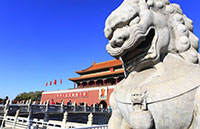China's sovereignty over South China Sea islands long recognized by intl community
Updated: 2016-05-15 08:26
(Xinhua)
|
||||||||
 |
|
An aerial photo taken on Sept. 25, 2015 from a seaplane of Hainan Maritime Safety Administration shows cruise vessel Haixun 1103 heading to the Yacheng 13-1 drilling rig during a patrol in south China Sea. [Photo/Xinhua] |
For quite a long period of time after World War II, no country had challenged China's sovereignty over the Nansha Islands and related rights in the South China Sea, long recognized by the international community, a senior Chinese diplomat said in an article.
The article, co-authored by Fu Ying, chairperson of the Foreign Affairs Committee of the National People's Congress of China, and Wu Shicun, president of the National Institute of the South China Sea, reviews the chain of events leading to the escalation of tensions in the South China Sea.
It combs the historical facts date back to ancient times that the sovereignty right of South China Sea islands belongs to China and has been recognised by the international community for a long time.
"This area in question was initially discovered and named by China as the Nansha Islands, over which China was the first to exercise sovereignty and that exercise has been ongoing," it said.
"Before the 1930s, there was no dispute over China's ownership of them, as reflected in many maps and encyclopedias published around the world."
It said the Cairo Declaration of November 1943, signed by the heads of the governments of China, the United States and the United Kingdom, proclaimed that "...Japan shall be stripped of all the islands in the Pacific which she has seized or occupied since the beginning of the first World War in 1914, and that all the territories Japan has stolen from the Chinese, such as Manchuria, Formosa, and the Pescadores, shall be restored to the Republic of China."
In 1947, the Ministry of the Interior of China's Nationalist government renamed a total of 159 islands, islets and sandbanks, including those of the Nansha Islands, historically under China's jurisdiction in the South China Sea. Meanwhile, the Nationalist government officially published a chart of its territorial waters that China had owned in the South China Sea demarcated by an eleven-dash line, the article noted.
"For a long time afterwards, the United States made no objections whatsoever. Given it being a long-term ally of Taiwan and its heavy presence in postwar Asia, the US had every reason to be aware of the existence of the chart. Obviously, China's position was recognized and acknowledged," it stressed.

 The world in photos: May 9-May 15
The world in photos: May 9-May 15
 Top 10 most generous companies in China
Top 10 most generous companies in China
 Wine market shrugs off slump
Wine market shrugs off slump
 Terracotta teddy bears debut in Wuxi
Terracotta teddy bears debut in Wuxi
 Karst wonderland in Southwest China
Karst wonderland in Southwest China
 Love on the rubble: wedding stories after deadly quake eight years ago
Love on the rubble: wedding stories after deadly quake eight years ago
 Italy's violin-makers struggle to hit profitable note
Italy's violin-makers struggle to hit profitable note
 High-tech gadgets shine at CES Asia in Shanghai
High-tech gadgets shine at CES Asia in Shanghai
Most Viewed
Editor's Picks

|

|

|

|

|

|
Today's Top News
Liang avoids jail in shooting death
China's finance minister addresses ratings downgrade
Duke alumni visit Chinese Embassy
Marriott unlikely to top Anbang offer for Starwood: Observers
Chinese biopharma debuts on Nasdaq
What ends Jeb Bush's White House hopes
Investigation for Nicolas's campaign
Will US-ASEAN meeting be good for region?
US Weekly

|

|







